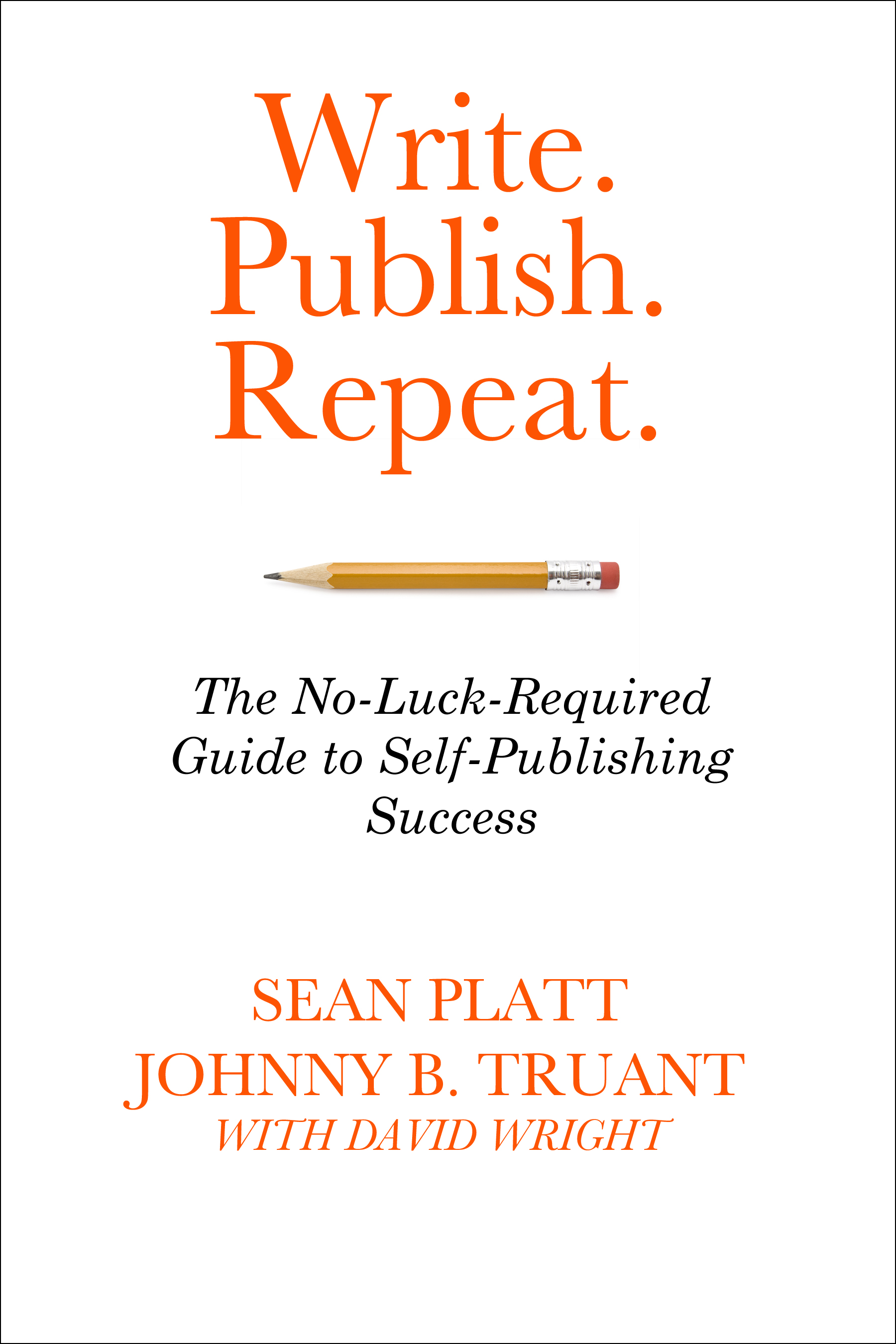Why You Should Use The Truant-Platt Publishing System
5 Ways Writers Can Make Money In The Digital Economy

The Undeniable Top 10 Digital Publishing Platforms
I’ve said before that I think Write. Publish. Repeat. by Johnny B. Truant and Sean Platt is one of the best books on independent, or self-, publishing I’ve ever read. And that’s why I’ve decided to follow the Truant-Platt independent publishing system for my publishing house Garden Gnome Publications. Today, I’d like to summarize the publishing plan they outline in their book.
I’ll do my best not to give away too much information because I think you’ll get more out of it if you read the book yourself.
Nevertheless, I feel like a summary is in order. I offer it here in 12 steps.
Step 1: Market Research
The first step in the Truant-Platt independent publishing system is to know your market. Conduct a little market research to determine
- Who your ideal audience is
- What they like
- What they don’t like
- And who is providing what that audience wants right now?
Once you know the playing field, you can better handle the challenges of reaching your target audience and producing a product they will want to buy.
Step 2: Choose a Market Segment
You can’t make everyone happy. So don’t even try. Identify a particular niche in the market you want to write for and ignore everyone else. It’s not rude. It’s just good business.
This is a good strategy whether you’re writing poetry, fiction, or nonfiction. Identify your market and write to that audience.
Step 3: Plan Your Book
This is a tricky step because you could get the impression that you should create an outline. Maybe that will help and maybe it won’t.
Truant and Platt divide writers into two groups: Planners and Pantsers. The planners like creating outlines. The Pantsers don’t. The Pantsers just write until they’re done and then go back and work out the details in the drafting and revision process. My friend Will Hutchison is a planner. I’m more of a pantser.
Neither is wrong. Both are right. Know thyself and be true to thine own style.
Step 4: Write Fast
Even Pantsers should have some idea about what direction they want their book to go. They may write as they go, but they have at least a vague outline in their heads as they write. They know what they want to happen, even if it changes midstream.
Platt and Truant say kick out a first draft fast. Just write. Don’t stop and revise. Just get it down. There’s plenty of time to perfect it later.
Step 5: Revise
After you have a first draft, that’s when it’s time to revise. Will, my historical fiction writing friend mentioned above, performs revisions in phases. He’ll go through on one phase and look for plot holes to fill. On another pass he’ll focus on one character. On another look through his manuscript, he’ll look for scene and setting issues that need to be fixed. This process takes a dozen steps or so, but he doesn’t miss anything.
It doesn’t matter what process you use for revision, you shouldn’t do it until you have a first draft to revise. Then, revise like hell.
Step 6: Edit Your Book
Editing is an entirely different process from revision, and it’s one where many independent authors take short cuts. You shouldn’t.
It is an expense. If you do it yourself, which I don’t recommend, it will cost you time. If you hire a professional editor, it will cost you money. Few writers are good self-editors. Choke up your pride and spend the money. You’ll have a much better manuscript for it. I promise.
So what’s an editor do?
A good editor does more than look for spelling and grammar mistakes. However, you can hire someone just to look over your manuscript and proofread it. If that’s all you can afford, it’s better than nothing. But I’d encourage you to spend a little more and hire an editor to really clean up your manuscript.
Fiction editors look for plot holes, characterization issues, scene and setting discrepancies, etc. Essentially anything that will make your fiction less than a work of art, your editor should point it out. It’s up to you to fix it.
Nonfiction editors look for logical flow and organizational elements that seem out of place, in addition to critiquing your writing style, use of metaphors, etc. This is one place most independent authors are willing to save money on, but you can tell it in their manuscripts. Platt and Truant – and myself too – recommend that you don’t skip this step.
Step 7: Produce a Cover
 People buy books based on the cover. Because of that, you should do everything possible to ensure you have the best book cover you can have. If you’re a good artist, you can probably do your own book covers. Most authors aren’t artists.
People buy books based on the cover. Because of that, you should do everything possible to ensure you have the best book cover you can have. If you’re a good artist, you can probably do your own book covers. Most authors aren’t artists.
When I published the Garden of Eden Anthology (cover to the right), I spent $120 on a professional book cover artist. That’s not cheap, but it’s not the most expensive artist either. It’s about middle range. Believe me, it was well worth it.
Don’t be cheap on your book cover. Not if you want to sell books.
Step 8: Format Your Book
I’m not going to cover any of the details on book formatting. There are resources for that. But this is the stage of the publishing process where you will format your book for print, the Kindle, the Nook, and any other format you want to sell in.
Step 9: Write A Product Description
I purposely call it a product description rather than a book description. I’m a big believer in treating your book (whether a print book or digital book) as a product. You are in the product merchandising business. If you don’t think so, then you are in for a rude awakening. People won’t buy your book because it’s good. They’ll buy your book because someone convinces them it’s good. You can do that with a well-written product description designed to close the sale.
I’d recommend studying sales writing techniques. Learn what a call to action and emotional trigger are, and learn the difference between a feature and a benefit. You’ll write much better book descriptions.
Step 10: Price Your Book
Just as important as your book cover and product description is the price you set for your book. If you price it too low, you’ll leave money on the table. If you price it too high, you won’t sell as many copies. There is an art to book pricing.
With nonfiction, people will pay for valuable information. Think of your product as the information inside, not the actual book.
With fiction, your name is your brand. If you are Stephen King, you can command a higher price. If you are an author no one has ever heard of, you are competing with Stephen King. I hope that doesn’t discourage you. But you can give yourself an edge by pricing your book right.
I’ll tell you right now, most of the books I buy are e-books. I buy mostly books by independent authors because they are usually $4.99 or less. Most of them fall in at $2.99 or less. Top level authors with an agent and a traditional publisher do not sell books (even e-books) for less than $9.99.
The price difference between independent authors and top authors makes it easier for me to buy an e-book by an independent author. Why? I can read more books for the same amount of money, and if I find a good author that I like, I can get a lot of books at a better price than I can if I’m reading James Patterson or Anne Rice.
Readers make choices based on their pocketbooks. It’s a reality we authors have to live with. Make the choice easier by learning to price your books.
Step 11: Publish
Now that you’ve got all the preliminaries out of the way, you can publish with confidence. You’ve got your book formatted, the price set, an awesome description, and a great book with a great cover. Put it out there into the world.
Step 12: Market Your Book
Just because your book is published, it doesn’t mean your job is done. You’ve got to find readers. And that requires marketing.
So how do you market your books?
There are a lot of ways to market a book. I won’t go into all of them here. In a nutshell, here are a few ideas:
- Write a blog
- Share your posts and sales material on your social networks
- If your book is in print, have a book signing and open reading at a book store or other appropriate venue
- For e-books, hold a webinar
- Go on talk shows
- Send out press releases
- Guest blog on other author’s blogs
- Write a newsletter
- Write more books
I’m not being facetious. The title of Truant’s and Platt’s book is Write. Publish. Repeat. Their entire publishing system is based on publishing more than one book. In fact, one of the things they do really well is publish serials. Each book in the series sells the others. And it’s making them tons of money.
Step 13: Do It Again
The Garden of Eden Anthology is my first book in a series I’m working on called the Biblical Legends Anthology Series. I offer it free for readers because I hope they’ll like it enough to read the others. I’m working on the second anthology, Sulfurings, right now. It should be published within the month. I’m taking submissions for the third, Deluge, as I write this.
I think Platt and Truant have some great marketing ideas. I’d recommend you read their book and follow their plan. It should work for both fiction and nonfiction authors. You could be the next great independent author.
Contact Allen Taylor or call
717-253-2306


